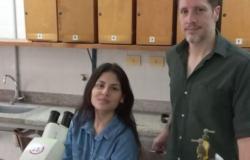The San Juan climatologist, the doctor German Pobletegave a master class on the factors that influence precipitation snowy in the Andes mountains at the height of the province of San Juan. The province is going through the worst water crisis in living memory and projections indicate that there will be no changes in that regard.
Dr. Poblete, in the talk that was given at the Vice Governor’s Rooms, from the Chamber of Deputies to technicians from institutions related to production, irrigation boards, rural leaders, teachers and climate specialists gave detailed detail of the reasons why “despite the fact that in 2023 there were over the current province of The boy– humid – there was no precipitation consistent with this condition.
This space for technical debate has been created based on the initiative of the Secretary of Water Resources and Renewable Energies led by engineer David Devia.
The average spill of San Juan River It is approximately 1420 cubic hectometers per year. But with the water crisis this has been reduced to almost a third, which implies that the area is at a very important water risk.
Dr. Poblete in his talk explained that not only the El Niño or La Niña Phenomenon influence the snowy precipitation regimes over the mountain range. This is why the Pacific anticyclone, Rossby waves, troughs or wedges also influence. This can lead to significant errors being made if a weather forecast is made taking into account the El Niño or La Niña current.
The specialist maintained that taking all these factors into account and according to his “own” model, in San Juan “there is a 51% chance that it will snow below normal, a 34% chance that it will be close to normal, and a 12% chance that it will be close to normal. % above normal.”
He explained that early snowfall is not an indicator that more snow will fall in the mountain range. He assured that “El Niño, which is a humid period, which was in force, entered a neutral state and it is expected that, for the months of July and August, the Niña – which has colder and drier characteristics – will already be in full force.” .
When adding seasonings to this climatic cocktail, Dr. Poblete remarked that “the El Niño Phenomenon lasts one year, while La Niña can last from 1 to 3 years, so drought periods can be longer than those with favorable conditions.






